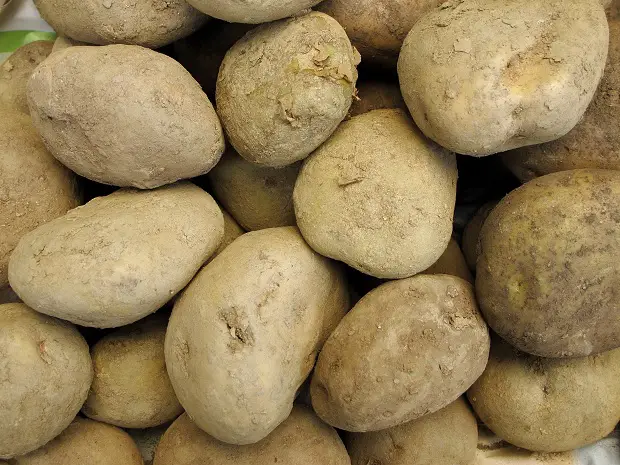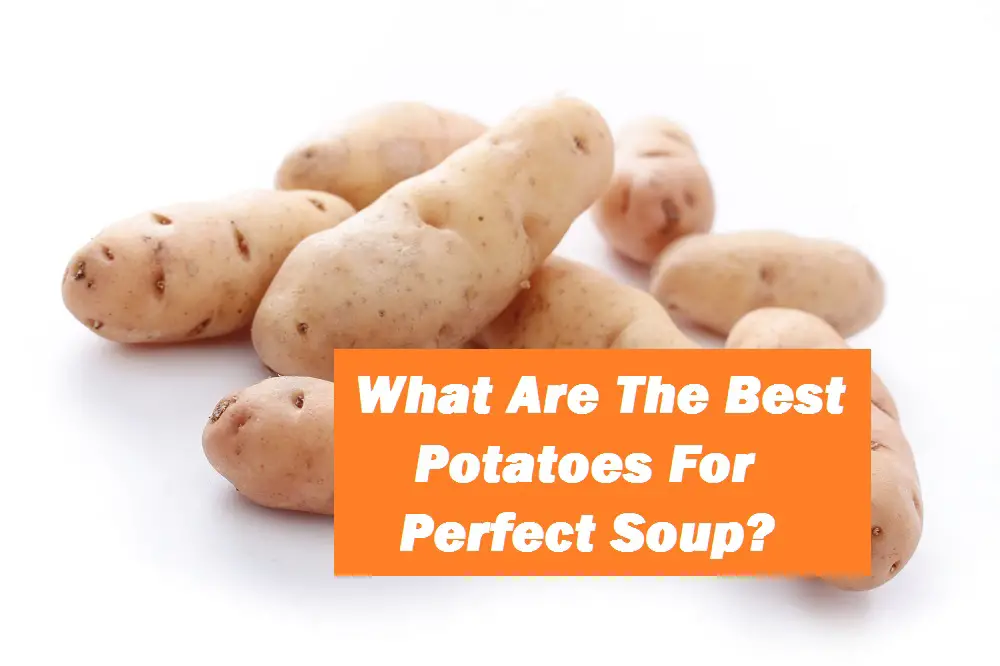From side dishes to snacks to even main dishes, potatoes are an important (and delicious) part of our everyday diets.
According to the Agricultural Marketing Resource Center, it is estimated that behind other staple crops like wheat, corn, and rice, potatoes are the fourth most important crop in the entire world.(1)
We can mash them, fry them, boil them, roast them, bake them, “pasta” them, and even dessert them.
Basically, just about any method of cooking somehow works for potatoes.
They are an extremely versatile vegetable to keep on hand in your kitchen.
When the weather gets a bit cooler, there’s nothing better than a good potato soup to warm up your frozen insides.
But with so many ranging varieties of potatoes available for consumption from your local grocery, it can be hard to determine which type of potato is best suited for your needs.
While they are classified under the same name of potato, not all are created equal, not by a landslide.
You may need some assistance in choosing wisely.
Potatoes 101
According to Wikipedia, “the potato is a starchy, tuberous crop from the perennial nightshade Solanum tuberosum” and it stands as one of the most widely-eaten vegetables in the entire world. (2)
While potatoes sometimes get a bad rap due to their starch content, the actual truth is that they are a good source of many of the vitamins and nutrients that our bodies need to maintain good health, such as niacin, Vitamin B6, protein, potassium, Vitamin C, and thiamin. (3)
When attempting to choose the best potatoes for your cooking needs, in general, you’ll want ones that are on the firm side and only have a few blemishes on the outside skin.
You’ll want to avoid any that have little sprouts growing off from their sides, as those sprouts will greatly affect the taste of the potato, no matter how you may be cooking them.
Note that it takes quite a while for potatoes to really go bad enough that they are unusable, so buying a large bag isn’t the worst idea if you can’t find the type of potato that you want sold loosely.
Plus, you’ll most likely end up saving money in the long run.
Just make sure you store your extra potatoes in a cooler, darker area of your home and remember, potatoes should never be put into the fridge for storage.
Lower temperatures can cause the starch in the potatoes to become sugar prematurely and they’ll end up taking on a much sweeter flavor than you’d want.
Eating the skin from potatoes is perfectly fine to do and there are many recipes out there that specifically call for the use of potato skins, but you will want to make sure that you clean the skins thoroughly before cooking and consumption.
Because potatoes are grown from the ground, they can be loaded with a lot of dirt, and are typically not cleaned very efficiently before hitting the supermarket aisles.
Types of Potatoes

There are between 3.000 and 5.000 different types of potatoes available.
That’s a lot of research to do just to choose what you want for dinner.
And not only does the range in potato types contrast in their appearance, texture, and taste, they can even have different steps for preparation and cooking!
We’ve scaled it down for you below, listing just some of the more common categories of potatoes and their distinctive characteristics.
Starchy
This breed of potatoes is (you guessed it) high in starch, a fact that over time has given them, and even all potatoes in general, somewhat of a negative image and/or have been encouraged to be avoided.
The fact is, starchy potatoes are some of the best to cook with because they contain very little moisture and tend to retain liquids extremely well.
These potatoes are the ones that you’ll want to use for such yummy things like French fries, baked potatoes, and mashed potatoes, any dish that you doesn’t call for the skin to be used; namely because it comes off so easily once they are cooked.
One of the most popular starchy potatoes is russets.
You can recognize these by their size; they are typically much larger than other potatoes.
Their skin is also on the darker-brown side. They are perfect for baking and also for frying up as chips.
Another favorite starchy potato is the sweet potato.
You can spot these by their pointy ends and oval shape. The insides are also very unique being orange-colored.
While they can also be baked like russet potatoes, their main uses are in desserts, most especially pies. And of course, they are a popular Thanksgiving recipe, topped off with marshmallows.
Waxy
These kinds of potatoes contain much less starch, but they make up for it in that they have almost double the amount of sugar.
They are usually on the smaller side with a thin layer of skin that does not separate easily like starchy potatoes; you’d really need to work to get the skin off these potatoes, which is why many recipes do not call for them to be peeled at all.
This makes them ideal for dishes where you want the potatoes to stay somewhat in one piece, like potato salads or a side dish of roasted potatoes.
A waxy potato favorite is the red bliss.
These potatoes are much tinier and rounder than most others, and can be easily distinguished by their red skin.
When cooked, they become very creamy, making them an excellent potato for roasting, steaming, or boiling.
Although they are not usually a good choice for smoothly-mashed potatoes, you can make a pretty good lumpy version with red bliss.
Adirondack blue potatoes are also very well-liked.
Like sweet potatoes, these can be recognized by their unusual interior color, which in this case, is a blue-purple mix.
They are especially great for casserole dishes. You may recognize their signature color in potato chip form as a snack option on JetBlue flights.
All Purpose

Just as their name suggests, all-purpose potatoes are good for just about anything.
They lie somewhere between the starches and waxy potatoes in that while they still do contain a moderate amount of starch yet they do not fall apart as easily.
All-purpose potatoes are the ones you’d want to use if you are unsure which particular potato a dish calls for.
Or if you can’t find a particular type of potato for your dish, your best bet is to choose an all-purpose potato. It’s the potato that you can’t go wrong with. Although, try naming a potato that is wrong!
Yukon gold are by far the most common of the all-purpose potatoes.
They are smaller than starchy potatoes, but not quite as small as waxy ones. Their skin is very thin, making it edible like waxy potatoes, and they are best suited for roasting and sautéing.
They are more buttery in flavor than other potatoes as well.
Soup Potatoes
With so many different breeds of potatoes out there, you would think that it would be a daunting task to choose which are best for soups.
But there are actually only just a few that you would want to use.
And then the choices get even more refined, as a lot of the time, the right potato will depend on what kind of soup you are making.
For hearty soups that call for chunks of different vegetables, waxy potatoes work best as they will keep their shape once they are cooked.
For soups that are meant to be blended down to a liquid, you’ll want to stick with something all-purpose like Yukon gold; especially if you are looking for that buttery taste.
You can certainly still use a starchy potato for these kinds of soups, but you may want to use them sparingly as starches will absorb liquids.
Golden Potato – Cauliflower Soup Recipe

What You’ll Need:
- Olive oil- 2 teaspoons
- Shallots, chopped finely- 1/3 cup
- Cauliflower, sliced- 2.5 cups or half a small head
- Yukon gold potatoes, peeled and sliced- 3/4 pound
- Chicken broth– 28 ounces
- Salt- 1 teaspoon
- Cayenne- 1/4 teaspoon
- Lemon juice- 1 teaspoon
- Chives, chopped- 2 teaspoons
What To Do:
- In a large saucepan, heat 2 teaspoons of oil on medium
- Add shallots, cover and cook for 2 minutes
- Add potatoes, broth, cauliflower, and salt and pepper. Bring to a boil.
- Reduce heat and cover. Simmer until vegetables are tender, about 15-20 minutes. Add lemon juice.
- Process all ingredients together until smooth.
- Top off with chives.
Use this guide to help you decide what potato you should use for everything from French fries to casseroles to mashed potatoes to soups.
You definitely don’t want to try and make French fries from an Adirondack blue…
Further reading: what are the best potatoes for vegetable soup?
Leave Feedback: Was this article helpful?

